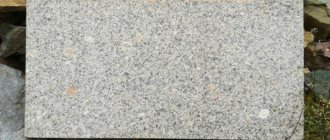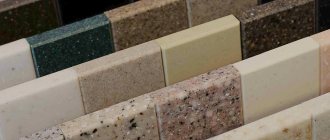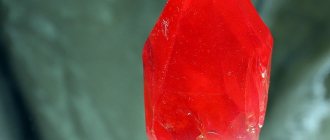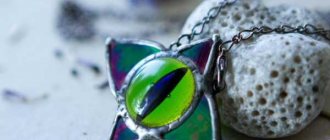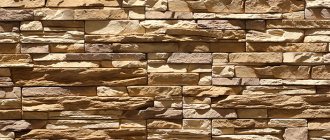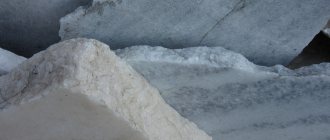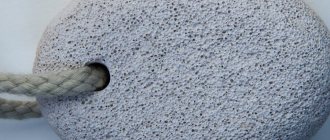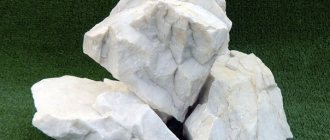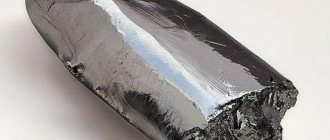Savage, or sandstone, is a stone of natural origin. Essentially it is sand cemented by nature. The variety of types allows it to be used in landscape, decorative finishing, and construction. People have also learned to make analogues. At home, artificial layers are formed, and in factories, flexible stones and hard slabs are made.
Origin of sandstone
Psammolite forms at the bottom of rivers, lakes, seas and oceans. First, rocks are destroyed and turned into psammit - sand, then it is mixed with natural cementing substances, compressed under water pressure over centuries and transformed into a high-strength mineral. This process is called lithization. Also, in some cases, rock cementation occurs without the participation of connecting particles: during mechanical compression (pressure at great depths) or melting in the solid state. The longer sand is compressed, the more mature and durable this building material becomes.
In the case of the formation of minerals at the bottom of the seas and oceans, after millions of years, as a result of the natural movement of the earth’s crust (tectonic activity), the relief rises, the bottom becomes mountains and plains on the surface of the earth, and large deposits of valuable sedimentary rocks become available for mining.
Making sandstone at home
You can make artificial sandstone with your own hands. To do this, you need a simple set of materials, including sand, clay, kitchen salt, and liquid glass.
All components, except salt, are mixed until a homogeneous mass is placed in a bath with a solution of sodium chloride.
The manufacturing process requires compliance with a number of subtleties. When preparing the mass, it is necessary to mix the composition thoroughly so that no dry matter remains. The prepared mass must be molded immediately, without leaving it to air dry.
It is necessary to place the entire product in the solution bath, without leaving an open surface. It is better to form massive products with cavities. This will save material consumption and allow the salt solution to penetrate deep into the product.
The remaining mass can be folded into a plastic bag, tied tightly and placed in a dark, cool room. It is important to avoid contact of the mass with air, which causes it to dry out and deteriorate the quality of the product.
Sandstone composition
Since this mineral is amazing in its diversity of species, there are many classifications by composition, domestic and foreign, that are scientifically interesting. Here we will focus on indicators useful to the stone processor, designer, builder and, of course, the buyer.
The most common is “savage” made from quartz sand. Less common are rocks made from feldspar, silicon, mica, glauconite and many other minerals. There are even rocks containing semi-precious impurities: tourmaline, opal, zircon, apatite, garnet, hematite, etc. Cement can be used: alumina, kaolin, silica, quartz, feldspar, opal, iron hydroxide (rust), etc.
There are also frequent inclusions of plant or animal nature, for example: wood in rock formed at the bottom of rivers, shells, fossil elements of extinct fish and animals in ocean stone.
Clayey sandstone with nummulites. The fragment includes grains of quartz, feldspar, glauconite, fragments and entire shells of nummulites (1–2 cm). Fine-grained, organogenic structure. The texture is layered.
Based on the amount of minerals in the sand, psammolites are divided into:
- monogenic (one mineral),
- oligomictic (two minerals),
- polymictic (three minerals or more).
History and origin of the mineral
Psammites (sandy rock) form over centuries at the bottom of deep-sea reservoirs. The savage is formed from fragments of minerals broken off by the current. The accumulation of sand grains sank into unwashed areas, reacted with other substances, and were pressed by the water column. The stone was found in places of dry lakes, seas, rivers, and lagoons.
Made from sandstone:
- Egyptian Sphinx;
- Peter's tomb (Jordan);
- minaret Qutub Minar (1368);
- St. Petersburg house of Kelch (1903);
- Palace of Versailles;
- Parisian buildings (by order of Napoleon III).
Symbols and statues of gods were carved from natural stone; columns and steps were made in temples. A historical complex has been preserved near the village of Busha in the area of the Yampolskoye field.
A pre-Christian rock temple, the city hall, and the remains of a fortress are made of sandstone. The age of some monuments dates back to the 3rd millennium BC.
Properties of sandstone
The data below is quite general.
If you need the parameters of the breed you have chosen, you should check them directly with the manufacturer or miner. The density of sandstone depends on the particle size, cementing agent, and other factors and can range from 1.6 g/cm3 to 2.77 g/cm3.
Some types are quite fragile, some are close to granite in strength.
It depends on external factors, the composition of sand and cement. For example, rocks with opal and chalcedony cement have high strength, while those with gypsum, clay, marly or calcareous cement have average strength. There are species that disintegrate in water. Hardness on the Mohs scale: from 4 to 6.
Dry compressive strength from 10 to 140 MPa.
Wear due to friction is 0.55-0.72 g/cm2.
Frost resistance - F50-F75. Withstands 50-75 freezing and thawing cycles.
Fire resistance - quartzite psammolite can withstand 1700-1770°C without physical changes.
Water absorption is low.
Some types have low thermal conductivity.
Artificial sandstone
Artificial wild animals are made in factories or at home. Factory-made sandstone with a uniform color is stronger and cheaper than natural material and does not require grinding.
How to make sandstone with your own hands:
- Dissolve rock salt in water at the rate of 0.3 kg/1 l (can be replaced with calcium nitrate fertilizer), pour into a deep container.
- Mix liquid glass, clay, sand in a ratio of 4:1:10 (do it in small volumes).
- Knead the mixture until smooth and beat like minced meat.
- Form stones.
- The stones are placed in a saline solution for 3 days (the liquid should cover the sandstone).
- Dry and polish.
No more than 330 kg of material is soaked in 100 liters of liquid. The remainder of the unused solution can be stored in a tightly closed bag with the air squeezed out at a temperature below 18 ºC away from light.
Types of sandstone
Based on the size of sand grains in the structure, psammitolites in Russia are classified as follows:
| Structure | Size of clastic grains, mm |
| Coarse-grained | 2 — 1 |
| Coarse grain | 1 — 0,5 |
| Medium grain | 0,5 — 0,25 |
| Fine grain | 0,25 — 0,1 |
| Fine grain | 0,1 — 0,05 |
Source: “Sedimentary rocks. Systematics and classification". Betkher O.V., Vologdina I.V.
You can also find heterogranular psammitolite - the result of the formation of a “savage” of particles that differ greatly in size. These may be larger pieces of rock from the early period than sand, as part of wild stone.
Quartzite-sandstone is very interesting - an intermediate link between quartz sandstone and quartzite. This breed is much denser and stronger than the “savage”. The process of transforming one mineral into another without melting is called metamorphism. Occurs as a result of high pressure and heat at the junctions of continental plates.
Quartz sandstone. The fragment contains quartz and small inclusions of feldspar and ore mineral.
Arkoses consist of more than 25% feldspar. The grains in the rock are angular and varied in size.
Arkose sandstone. The fragment contains grains of quartz, feldspar, hematite, and mica flakes.
Graywackes are very durable polymictic heterogeneous rocks of graphitic, black color with many unexpected shades and impurities.
Graywacke sandstone. It consists of acute-angled grains of plagioclase and fragments of volcanic-sedimentary rocks.
In lithography - printing designs using stone, lithographic sandstone was used - a high-density mineral with a homogeneous composition. It was sanded, a pattern was applied, then etched with a special compound and washed off. The result was a stone stamp, onto which paint was then applied and impressions were made.
It is also worth saying a few words about what is called shell sandstone. Essentially, it is limestone. It consists of fragments of shells that form a porous structure, lime cement, and sometimes sand. This fossil is more fragile, so it is used only for decoration.
A special place is occupied by oolites and pisolites - porous deposits of ooids - small balls cemented together. Pisolites are distinguished by the fact that the balls are larger than in oolites, more than 2 mm. in diameter. Oolite is also called egg stone, and usually it is also not sandstone at all, but limestone. Like other sedimentary rocks, they can vary greatly in composition.
According to the degree of processing, they are divided into: rubble stone (unprocessed), plastushka and fontanka (naturally breaking off pieces), flagstone (more dense “savage”, cut into plates), for construction they are cut into blocks suitable for masonry.
For decorative purposes, you can easily select sandstone of the desired texture: rough, rough or smooth. It depends on the size of the sand grains and the processing method. To obtain a smooth sandstone, it is ground and polished. Sometimes a protective coating is applied to preserve the natural color.
Tumbled stone is popular - processed in a special drum with abrasive particles. The result is something between simply cut pieces and those that in nature have been doused with water for years to form smooth “rounds” - pieces with uneven but rounded edges and a smoothed texture on the flat parts.
Slates
Mica schist is a metamorphic rock consisting of tiny grains of quartz and mica, which has the characteristic feature of breaking into thin slabs (“foliation”).
Color - dark to black; There are varieties of greenish color with a pattern.
The size of the slabs is usually 0.5-1.0 m2; individual slabs - up to 3.0 m2.
Application. Slates that split into thin tiles (4-8 mm) are used for roofing, while those consisting of thicker slabs are used for making window sills, steps, partitions and floors.
Due to the delamination of slate, it is not allowed to be used in the form of piece stone. In most cases, slate does not require polishing and is used with a natural or polished texture, the latter quite fully revealing the shades of its color and pattern.
Sandstone color
Due to the wide variety of factors influencing the formation of the breed, this environmentally friendly material pleases designers and owners of private houses with a wide color palette and a decent selection of patterns. Moreover, each cut has a unique pattern.
The most common is the gray “savage”, with a brownish or greenish tint - the glauconite type.
The presence of iron in the composition gives the mineral a rusty-brown or dark red tone - this is an elite red sandstone. It is very beautiful and durable. In addition, it does not fade under the sun, and is not afraid of significant changes in temperature and humidity. Probably the reason is that this species was formed in an older period and “matured” longer.
Some shades of red are obtained by firing raw materials in ovens at a temperature of 400-550 °C. As a result, the color palette expands from pink to terracotta. In addition, the practicality of the mineral increases: hardness and resistance to environmental influences increase.
Luxurious white sandstone and light gray are usually 90% quartz. They are often used to decorate facades, columns, and create architectural elements and sculptures.
Dark brown and black sandstone are formed as a result of the admixture of organic substances - bitumen. It looks presentable, especially in the decoration of facades and fences.
Gray-blue, gray-blue, gray, dark gray shades can be found under the general name: blue sandstone. This is a very durable material. The “dragon” texture looks especially impressive in this color.
The so-called yellow sandstone appears yellowish-brown or light brown due to phosphate cement. Very common in nature. The surface is rough, granular. Frost resistance is high, but strength is not very good, for this reason it is used for finishing.
You can also find other colors and design names: raspberry, honey, terracotta, tiger, tiger pink, rainbow, cappuccino, fallen leaves. The pattern is attractive, similar to wood: yellowish, yellow-brown, light brown with characteristic stains. Tiles with an amber pattern look beautiful.
Physicochemical characteristics
Sandstone does not have uniform physical and chemical properties. If we talk about all the deposits of the world, then the range of characteristics of this mineral is as follows:
- rock-forming substance – quartz, feldspar, mica, glauconite;
- impurities - garnet, tourmaline, rutile, magnetite, ilmenite;
- hardness – 1600-2700 kg/m³;
- density – 2.25-2.67 g/cm³;
- sand grain size – 0.05-2 mm;
- water absorption – 0.63-1.57%;
- porosity - 0.63-1% for quartz savages, 1.5-2.73% for clay varieties;
- resistance to temperatures - up to 1690°C siliceous and quartz sandstones.
In terms of density and fragility, sandstone is between limestone and granite, and low moisture absorption and resistance to sudden temperature changes make it possible to build reliable and durable structures from this stone in variable climates.
Sandstone, like granite, is strong and durable, and has several significant advantages. Its cost compared to granite is an order of magnitude lower, and the color range is wider, and the design is distinguished by intricate patterns that arise due to smooth transitions of colors from one to another. In addition, sandstone is easy to work and, when properly processed, has a high resistance to wear.
Sandstone deposits and mining
Deposits of the mineral are distributed throughout the world.
In Russia, this mineral was discovered in the Moscow and Kemerovo regions, in the Volga region, in the Urals, in the North Caucasus and Transcaucasia, in Eastern Siberia and the Far East.
The quarries are especially famous in the Rostov region and Dagestan. In Karelia, not far from the village of Shoksha, the ancient red quartzite-sandstone of the Proterozoic period, Shoksha porphyry, famous throughout the world, is obtained.
Shokshinsky porphyry - red quartzite-sandstone
They are mined in different ways, depending on the depth, size and strength:
- Stone-cutting. The most accurate, practical and gentle option. The fossil is cut into pieces.
- Air cushion method, or controlled explosion. A safe, gentle technique that allows you to obtain a material without microcracks. Holes are made in the formation into which air is pumped. Under air pressure, the mineral splits. Predictable places of splits.
- Drilling and blasting. The most dangerous method with big losses. Used for durable quartz and siliceous rocks when other options are not suitable. Holes are drilled in the rock where explosives are placed. After the explosion, pieces of uneven shape are obtained, about 70% of the volume and crushed stone - about 30%. The material is obtained with hidden defects.
Extraction of sandstone
The resulting raw material is sawed, then cut into standard blocks and slabs. Some of the material is sent to the factory for further processing, some is packaged, shipped directly from the quarry and delivered to customers throughout the country.
Description and properties
Sandstone in nature was formed from quartz particles bound together by alumina and various minerals: opal, calcite, chalcedony and others. Natural elements carried rock fragments.
By the roundness of the stones, the size and presence of various particles, one can judge the origin and movement of sandstone. Modern deposits are known in the Urals, in Siberia, and are rich in rocks in the territories of Kazakhstan, Poland, and Bulgaria.
The varied color of the rock depends on the content of binder components. Iron ore creates unique patterns. Each stone cut is individual, so it has always attracted the human eye. Several thousand years ago, the material was already used in the construction of tombs, dwellings, and palaces.
In construction, decorative facing stone is valued for many characteristics:
- excellent aesthetic parameters;
- safety and environmental friendliness;
- variety of types of cuts and colors;
- ease of care;
- inertness of the material (no reaction to other building compounds);
- durability of natural stone;
- flexibility in processing: sawing and grinding;
- affordable price.
The only drawback of the building material is its heavy weight, reflecting the considerable density of the material. This indicator may differ depending on the variability of the sandstone composition.
In comparison with other natural materials, in terms of this property its position is between limestone and granite. Of course, the unshakable power of granite remains unchanged through the centuries. But the advantages of sandstone are ease of processing and variety of palettes.
Proper impregnation of the material and additional coating can turn the rock into a monolith that is not subject to wear. Stone blocks can withstand heavy loads of several tons per 1 sq.m.
Sandstone stone is distinguished by high chemical and physical properties, thanks to which it is not afraid of moisture and is resistant to weather changes, sudden thaws and severe frosts. The structure of the stone remains unchanged for many years.
Siliceous sandstone rocks have the highest strength, while stones with dolomite and limestone layers have the least strength. High fire resistance is characteristic of quartz sandstones with cementitious silicon.
In construction work, sandstone, unlike expensive granite and marble, does not require large expenses. In cladding, internal and external, laying on cement mortar is allowed.
The torn sandstone is randomly hammered in rows to form the finish. Very large pieces are not required here. The versatility of the material is evident in its manufacture
- fireplaces;
- countertops;
- window sills;
- fencing;
- facade tiles;
- other shaped products and finishing.
There is an artificial analogue of smooth sandstone , which is easy to distinguish from natural material. Natural stone has a granular structure, no clear lines, and vague inclusions of minerals.
The true sample needs to be ground, as it has an uneven, rough surface. Artificial stone is initially even and smooth, requiring no processing. The color is monochromatic with clear lines of the pattern. Artificial materials are cheaper, but they do not have the characteristics and properties of natural stones.
Where is it used?
- Architecture. Many architectural monuments were built from it or decorated with it. In St. Petersburg alone there are about 30 objects.
- Sculpture. For example, the Egyptian Sphinx.
- Construction of private buildings. There are types that have low thermal conductivity, thanks to which you can build an excellent sandstone house that will be warm in winter and cool in summer.
- Stone tile cladding of walls, floors, fireplaces, stairs.
- Balusters for stairs, columns, balustrades, window sills, countertops, sinks.
- Decorative items in the interior: flowerpots, statues, fountains.
- Mosaic: panels, bas-reliefs.
- Crafts.
- Laying and pouring the foundation - add crushed stone to the solution.
- For interior wall decoration, they are used in a similar way, choosing smaller fractions.
- Cladding of facades, steps, barbecue areas, blind areas, fences, gazebos.
- Sidewalks and garden paths.
- Landscape design: individually lying natural boulders of interesting shapes, garden sculptures, alpine slides, framing of flower beds, waterfalls, fountains, even laying out the bottom and coast of small reservoirs.
- Production of dinas - refractory bricks for lining the internal walls of electrometallurgical, open-hearth, coke and glass furnaces.
- Glass production.
- Asphalt production.
- As a flux in the smelting of copper and nickel.
- Raw materials for the production of ferrosilicon, silicon carbide (carborundum) and silumin (an alloy of aluminum and silicon).
- Production of millstones, grinding stones.
- Fertilizer production.
- Lithography is one of the ways to reproduce drawings.
- Jewelry production: beads, bracelets, earrings.
- Decoration of aquariums and terrariums - the cavernous type is most often used here: bottles of various shapes in white, beige and yellowish shades with a large number of through holes.
- Lithotherapy - treatment by applying heated stones and massage.
- Orthopedic tracks for children.
- Funeral services - slabs, monuments.
Egypt. Sphinx.
History of the mineral
The history of sandstone formation goes back millions of years. Five thousand years ago it began to be used for the construction of homes and shelters. This is evidenced by rock paintings discovered in caves and grottoes that have survived to this day.
Due to the esoteric properties of the stone, buildings and complexes have been erected from it since ancient times. As a building material, it enjoyed great success in Paris during the time of Napoleon III. In Jordan, the tomb of Petra was built from sandstone, and in the pyramids of Egypt there is the famous Sphinx.
Variety of sandstone
The first thing a person sees is what a sandstone stone looks like.
It is distinguished not only by its chemical composition and physical properties, but also by color. For example, red sandstone is considered the most expensive and durable; it has been mined in Karelia for a long time; the rocks there can have different colors, from pinkish-orange to crimson.
The most common and accessible stone is sandstone with a yellow tint. Based on the combination and compression of clay rocks and sand, this particular species is formed. The binding agent in this union is clay. It is not so durable and therefore it is most often used to cover country and garden paths, but over time it loses its strength and begins to crack, requiring partial replacement.
